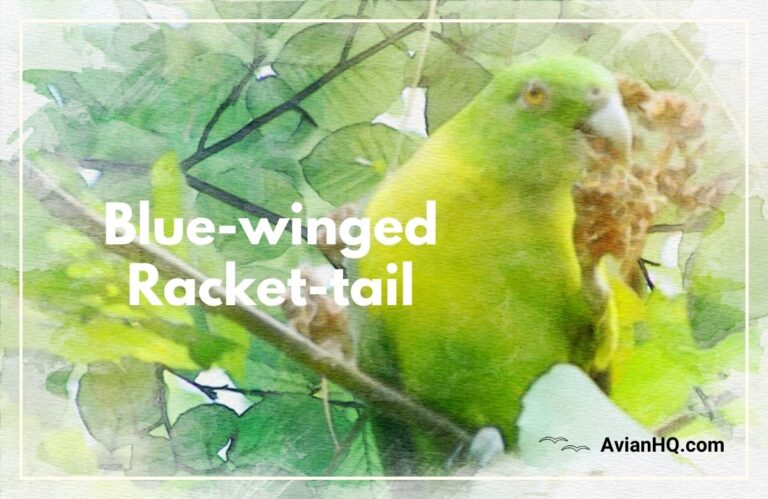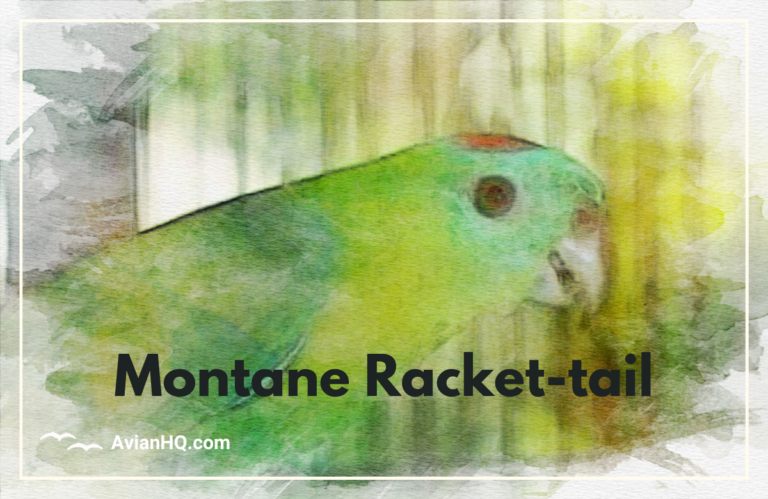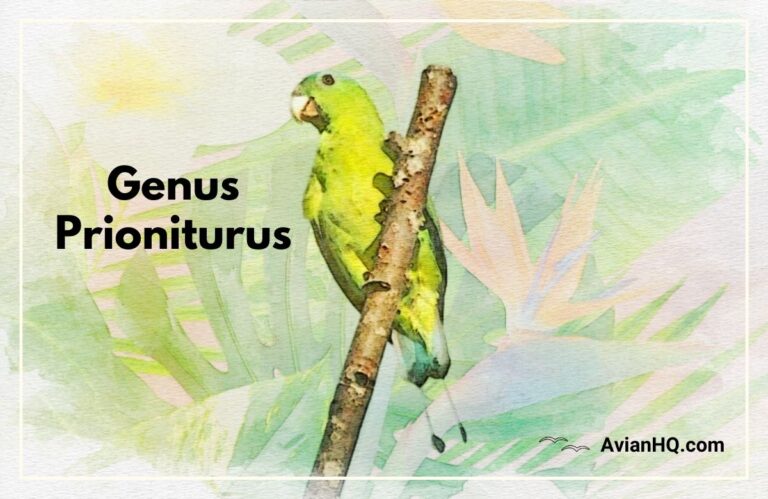Blue-crowned Racket-tail Parrot (Prioniturus discurus)
With it’s bright green plumage and distinctive blue crown, the Blue-crowned Racket-tail Parrot is truly a sight to behold. This medium-sized, vibrantly colored parrot endemic to the Philippines has some features that make it unique among it’s parrot relatives. Most notably, it possesses elongated central tail feathers that end in paddle-shaped “rackets”—a trait found in no other parrot species.
The Blue-crowned Racket-tail’s scientific name is Prioniturus discurus. It also goes by the common names Blue-crowned Racquet-tail and Racket-tailed Parrot. It’s popularity in the pet trade and habitat loss place pressure on wild populations. Learning more about this marvelous parrot—from it’s taxonomic classification to it’s role in Philippine forests—can help efforts to protect it.
This article will provide a comprehensive overview of the natural history, physical appearance, distribution, diet, and conservation status of the Blue-crowned Racket-tail Parrot. It will detail key facts while aiming to inspire appreciation for this distinctive bird. Whether a casual bird enthusiast or seasoned ornithologist, readers will come away with a deeper knowledge of this eye-catching parrot.
History and Classification
The first scientific description of the Blue-crowned Racket-tail was published in 1831 by French naturalist René Lesson, who gave it the scientific name Psittacus discurus. In 1863, it was moved to the genus Prioniturus by German ornithologist Otto Finsch.
Within the parrot family (Psittacidae), the Blue-crowned Racket-tail belongs to the subfamily of lories and lorikeets (Loriinae). It’s genus Prioniturus contains six other species, all native to southeast Asia. These parrots are characterized by their specialized tail feathers that end in a spatula or racket shape.
Today, most authorities recognize four subspecies of the Blue-crowned Racket-tail:
- P. d. discurus: Jolo, Mindanao, Olutanga, Basilan, Guimaras, Luzon
- P. d. whiteheadi: Negros, Bohol, Samar, Leyte, Masbate, Cebu
- P. d. nesophilus: Tablas, Sibuyan, Catanduanes
- P. d. mindorensis: Mindoro
These subspecies differ slightly in the amount of blue plumage on the crown. The Blue-headed Racket-tail (P. platenae) was previously considered a subspecies but is now recognized as a full species.
Physical Appearance
The Blue-crowned Racket-tail is a medium-sized parrot, measuring approximately 27 cm (10.6 inches) in length. It weighs between 140-160 g (4.9-5.6 oz).
The adult plumage is predominantly bright green. The face is a vivid emerald green. The most distinctive feature is the deep blue crown extending from the forecrown to the nape. The underside of the tail is bluish, while the uppertail coverts are green edged with blue. The beak is bluish-gray and the irises are dark brown.
The racket-shaped tail feathers that give the species it’s name are unique. The two elongated central tail feathers have black shafts and blue “rackets” at the ends.
Juveniles have less blue in their plumage, especially on the crown. Young birds lack the long, specialized tail feathers. The blue coloration increases as they mature.
There are subtle differences in the amount of blue on the crown between the four subspecies:
- P. d. discurus: Most extensive blue crown
- P. d. whiteheadi: Less blue on crown, blending into green
- P. d. nesophilus: Forecrown green, hindcrown lilac blue
- P. d. mindorensis: Forecrown green, no blue on crown
Habitat and Distribution
The Blue-crowned Racket-tail is endemic to the Philippine archipelago. It’s total geographic range extends across most of the larger islands except for Palawan and Panay.
The four subspecies each occupy a distinct region:
- P. d. discurus: Jolo, Mindanao, Basilan, Olutanga
- P. d. whiteheadi: Southern Luzon, Catanduanes, central/eastern Visayan islands
- P. d. nesophilus: Tablas, Sibuyan, Catanduanes
- P. d. mindorensis: Mindoro
This parrot inhabits primary and secondary forest up to elevations of 1,750 m (5,740 ft). It is found along forest edges and in trees around clearings and cultivated areas. The Blue-crowned Racket-tail prefers tropical humid forests but also utilizes mangroves.
Diet and Feeding
In the wild, the Blue-crowned Racket-tail feeds on a variety of fruits, berries, nuts, and seeds. Some known food sources are figs, bananas, and native Philippine vegetation.
These parrots forage for food in small flocks of 5-12 individuals. Groups congregate in fruiting trees where food is abundant. Their diet consists mainly of plant material but they likely ingest some insects as well.
In captivity, Blue-crowned Racket-tails adapt well to eating bird pellets, seeds, vegetables, and fruit. Recommended foods include:
- Pellets fortified with vitamins and minerals
- Whole grain breads
- Cooked corn, peas, carrots
- Apples, pears, oranges, berries
- Nuts, sunflower seeds
- Leafy greens like kale
A varied diet with both seeds/pellets and fresh produce is ideal. Clean, fresh water should be available at all times.
Breeding and Reproduction
In the wild, the Blue-crowned Racket-tail nests in tree hollows, either in limb forks or inside the trunk. The nesting sites are often in large emergent trees.
This parrot is thought to nest colonially, with many pairs aggregating in the same tree or grove. Pairs may reuse the same nest site across different breeding seasons.
The breeding season varies across the range – April to May in Negros, May in Leyte, and April in Mindanao. The female lays a clutch of 2-4 rounded white eggs that measure approximately 31.5 x 26 mm (1.2 x 1.0 inches).
Both parents incubate the eggs for around 23-25 days. Once hatched, the chicks are fed and cared for by both parents. The young fledge at 8-9 weeks old and resemble adult plumage by one year old.
In captivity, Blue-crowned Racket-tails can start breeding at 2-3 years old. Providing proper nest boxes encourages breeding behavior. The average clutch size is 3-4 eggs with an incubation period of 24 days.
Conservation Status
The Blue-crowned Racket-tail is evaluated as Least Concern on the IUCN Red List. It’s total population is unknown but presumed to be stable. However, the species faces threats from habitat destruction and trapping for the pet trade.
Across it’s range, lowland forests have been widely cleared for agriculture and development. This habitat loss puts pressure on racket-tail populations, though they still utilize gardens and trees around human areas.
These colorful parrots are popular in the cage bird trade. Trapping of wild birds for aviculture may impact local populations. The Blue-crowned Racket-tail is listed under CITES Appendix II, which regulates their trade.
While not globally threatened, continued habitat conservation is needed to protect this and other Philippine endemics. Ecotourism and aviculture initiatives could provide local people with alternatives to trapping wild parrots.
Cultural Significance
The Blue-crowned Racket-tail is endemic to the biodiverse islands of the Philippines. Though not a national symbol, it represents the uniqueness of Philippine parrot diversity.
This parrot’s popularity in aviculture stems from it’s striking appearance and unique tail. However, few reach the commercial pet trade due to regulations on trapping wild birds. Most captive racket-tails today are bred rather than wild-caught.
In the Philippines, racket-tails are admired for their beauty but not deeply rooted in folklore or culture. More significant species like the Philippine Eagle overshadow it. Yet for bird lovers around the world, this parrot symbolizes the Philippines’ rich avifauna.
While not integral to Filipino culture, protecting the Blue-crowned Racket-tail is still important. It’s conservation helps preserve Philippine forests, benefiting both wildlife and local communities. Though obscure, this parrot deserves recognition and habitat protection.
Conclusion
The Blue-crowned Racket-tail is a vividly plumed parrot restricted to the Philippine archipelago. It’s most distinctive feature—elongated tail feathers ending in paddle-shaped “rackets”—makes it unique among parrot species globally.
While not considered threatened, this endemic parrot requires continued habitat conservation across it’s island range. Forest protection benefits both the racket-tails and more endangered Philippines species.
Though it lacks cultural significance locally, the Blue-crowned Racket-tail remains a symbol of the region’s high bird diversity. It’s bright colors and novelty tail structure will continue to attract avicultural interest. Yet trapping for the pet trade should be limited to sustain wild populations.
Standing out for it’s racqueted tail and emerald-blue plumage, the Blue-crowned Racket-tail aptly reflects the singular beauty of Philippine parrots. Conserving this special species and it’s rainforest home is crucial for preserving the country’s natural heritage.







